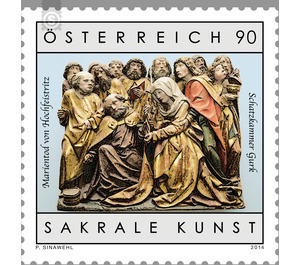Sacred art - Austria / II. Republic of Austria 2014 - 90 Euro Cent
Theme: Art & Culture
| Country | Austria / II. Republic of Austria |
| Issue Date | 2014 |
| Face Value | 90.00 |
| Edition Issued | 220,000 |
| Printing Type | Combination printing, offset stitch (Etch-Art by OeSD) |
| Stamp Type | Commemorative |
| Item Type | Stamp |
| Chronological Issue Number | 2483 |
| Chronological Chapter | OOS-OE2 |
| SID | 942022 |
| In 65 Wishlists | |
As a continuation of the series "Sacred Art", Austrian Post is issuing a special stamp presenting a piece of artistic and church history value: the Marian Death of Hochfeistritz, a colorful wooden relief from the beginning of the 16th century. As Marientod or Dormitio Mariae (in the Orthodox Church "Koimesis") is in the visual arts, the recurring theme of the dying mother of God, which is surrounded by the apostles, called. In Byzantine art, the first Marientod representations were made around 900, in the West at the turn of the millennium. Apocryphal or extra-Canonical writings, which have always been the source of inspiration for artists, speak of the announcement of the near death of Mary by an angel. She wishes to meet once again the apostles, who are finally sent on clouds to their deathbed. She receives Holy Communion from John, and she is escorted to heaven by Christ, the patriarchs and an angelic crowd. The Marian death of Hochfeistritz was originally part of the religious inventory of the parish and pilgrimage church to "Our Lady in the Fichte", an imposing fortified church on the southwestern foothills of the Carinthian Saualpe. The late Gothic church was built in the second half of the 15th century and was supposed to protect walls, loopholes and its defensive tower from invading Turks. The precious relief was set up in the canteen of the south aisle. Today, there is a copy of the Marian Death, the original was kept for a long time in the Klagenfurt Diocesan Museum. The museum and with it all the exhibits have now found a new venerable place: In May 2014 opened the "Treasury Gurk" in the provost's court of the famous cathedral to Gurk their doors. More than 300 sacred works of art from Carinthia are displayed on around 700 square meters, reflecting the ecclesiastical history of the country. Each epoch is attributed to a space in which the Gothic with its rich treasure of religious relics is a focal point - here the death of the Blessed Virgin by Hochfeistritz is presented alongside winged altars, panel paintings, single sculptures and other treasures.


